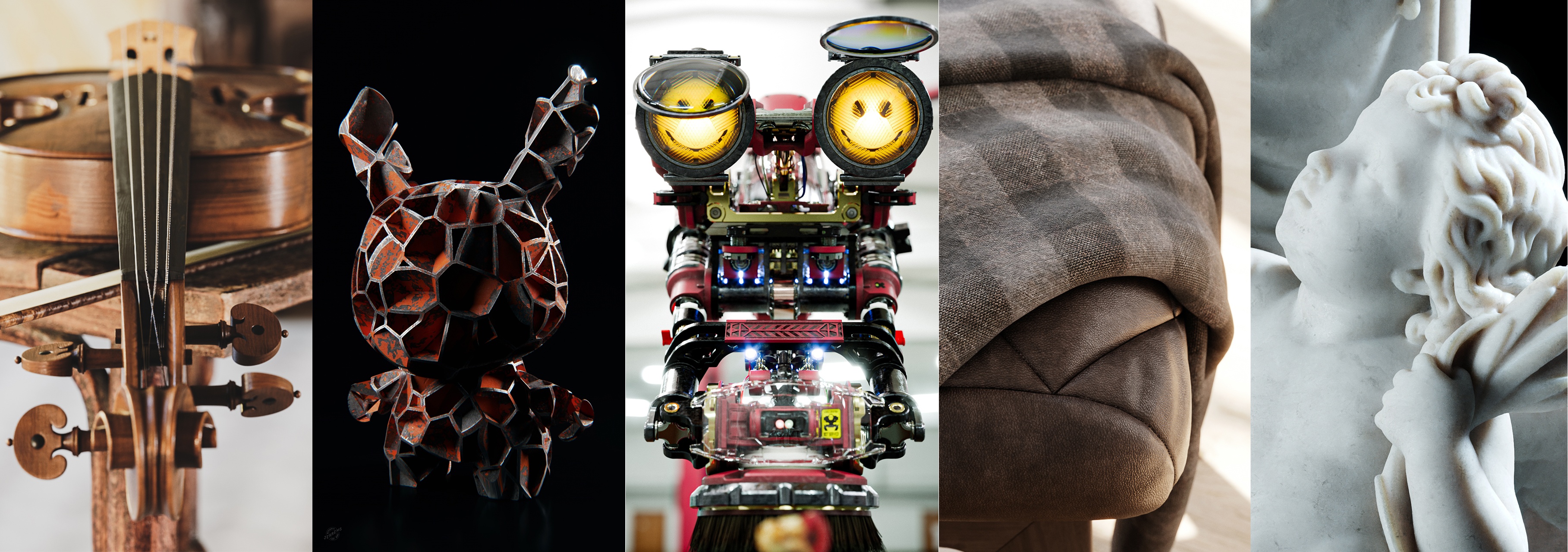This page provides information on the Corona Physical Material, its settings, and usage.
Overview
The new Physical Material is introduced in Corona Renderer 7 for 3ds Max and Cinema 4D. This material has been designed from the ground up and is intended to replace the previously default Corona Material, which in version 7 is called Corona Legacy Material. Some of the benefits of the Physical Material are its ease of use and its ability to achieve realistic results ensuring you can't accidentally create unrealistic "fake" materials that break energy conservation and other laws of physics regardless of the settings you use. The result will always be (and look) realistic.
The Physical Material also includes presets that you can easily select from a dropdown menu. These include materials such as Aluminium, Brass, Chrome, Copper, Diamond, Glass, Gold, Iron, Mirror, Plastic, Plexiglass, Satin, and even Velvet.
Why was it added?
The Corona Physical Material was added as the replacement of the old Corona Material. Some of the benefits of the Physical Material include:
- The ability to get more realistic and physically plausible results easier;
- Better and easier layering system without the need to set up complex Layered Material networks (clearcoat, sheen);
- Compatibility with other software following the physically-based (PBR) guidelines.
How is it better than the old Corona Material (now called Legacy Material)?
There are many benefits over the old Corona Material. For starters, Corona Physical Material offers a natural way to set up realistic materials, making various workflows much more intuitive and simpler in the long run. Its diffuse calculations have been switched from Lambertian to the Oren-Nayar model, so even the simplest of materials will now look better and be rendered more physically correct.
In addition, fake and non-physically plausible material properties are not possible anymore, the current material parameters are designed in a way to prevent such cases.
When to use the Corona Physical Material?
The Physical Material should primarily be used as the new default for any newly created materials, unless it is absolutely necessary to use the Corona Legacy Material (e.g. in case of re-rendering older scenes).
Corona Physical Material Settings
In this example, the Thin Film layer of the Corona Physical Material is enabled, and a CoronaMappingRandomizer texture is applied to the Texture slot. This setup simulates the optical phenomenon of thin-film interference, resulting in an iridescent effect - similar to the shimmering colors seen on the surface of soap bubbles.
Thin Film is OFF
In this video, the Thin film layer is disabled.
Thin Film is ON
In this video, the Thin film layer is enabled.
Side-by-side comparison
The example below compares the same bubbles with the Thin Film layer turned off and on, side by side.
Example: Thin Film Amount
This example shows the effect of the Thin Film's Amount material.
Amount = 0
Amount = 25
Amount = 50
Amount = 75
Amount = 100
Example: Thin Film Max Thickness
This example shows the effect of the Thin Film's Max Thickness material.
Max Thickness = 0
Max Thickness = 100
Max Thickness = 200
Max Thickness = 300
Max Thickness = 400
Max Thickness = 500
Max Thickness = 600
Max Thickness = 700
Max Thickness = 800
Max Thickness = 900
Max Thickness = 1500
Max Thickness = 5000
Example: Thin Film IOR
This example shows the effect of the Thin Film's IOR parameter.
IOR = 1
IOR = 1.3
IOR = 1.5
IOR = 1.8
IOR = 2
IOR = 3
Media options
Advanced options
Maps options
Refract BG Override Example
In this interior scene, a Corona Sky Map is used as the main environment map, providing natural daylight illumination throughout the room. To enhance the view through the windows, a forest HDRI map is assigned to the Refract BG Override slot of the glass material. This makes the forest scenery visible only through the glass, while the lighting continues to come solely from the Corona Sky Map.
Reflect BG Override Example
In this example, a clear Corona Sky Map is used as the main Scene Environment, providing a clean lighting setup. However, an HDRI map with visible clouds is applied to the Reflect BG Override slot of the water material. This allows the sky from the HDRI to appear only in reflections on the water material, which is clearly visible on the water surface, adding visual interest without affecting the overall lighting of the scene.

































